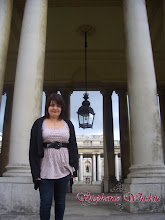Tuesday, 15 December 2009
Production Design
Friday, 11 December 2009
Diary for TV Quiz Show Production
3rd – 5th Nov – I was briefed the group assignment, to produce a Live TV Quiz Show. I was shown how to use the TV Studio equipment, the technical terms used in a TV Studio and analyse opening titles and closing titles for other shows similar to the one we as a group were going to make.
9th – 12th Nov – The group were put into smaller groups for different round; mine was the quickfire round, with Sharni, Amy, Reece, Alex and myself. We had to come up with questions for that round that were based around music, film, TV and internet. Even though I was technical producer in my group, I help design the set. I was shown how multi camera productions work and help to find inserts and pictures for our round.
16th – 19th Nov- We finalized the questions we were going to use for our round and our rounds running order done. I also helped getting the flats painted. I got to practice on cameras on Wednesday and helped editing the content for our round.
23rd – 26th Nov- We went off and done our rounds script on Monday. I help paint the set that week, also got to practice shots and had a go at directing on Wednesday and started to make cue cards on Thursday
30th Nov – 3rd Dec – I help finish paint the set and continued to make the cue cards, once the set was finished being painted we put it all together to see how it would look.
7th – 10th Dec – We put the set all together and started to rehearse with it in place until Wednesday when we recorded our TV show and then watched it back to comment on it. I also helped get the script done in time for Wednesday.
My role as technical producer went well, as I told our quickfire group what we could and could not do. Although there was not much to do as technical producer, I helped in other areas that needed my help to get the show running. When we were recording our show “Media Meltdown”, for the first half I was Assistant Director, this involved me telling the director what type of Inserts were coming next and timing the how long they were.
Monday, 7 December 2009
Cameras


When lining up for shots it is important that the eyes remain on the upper third and that there is looking room, so whichever direction that the talent is looking that there is some space in the direction that they are looking. Also it is good if the camera person can line the talent in one of the two vertical line, this makes it look more professional than putting the person right in the middle. There are also many things that a camera person can do to make the show professional i.e. like having an over the shoulder shot, this will give more depth of the studio and this will show items in the foreground, middleground and, if the person isn't straight up on against the wall, some background. Also crabing left/right and peding up/down on a wide shot will give more sense of the space in a studio. Although giving something in the foreground, middleground and background gives the audience a sense of space, the director will use a shot with only two of the three things on the ground i.e. so they would still use a shot with something in the middleground and background.
Studio Crew

Tuesday, 10 November 2009
Audio and Vision Pathway





